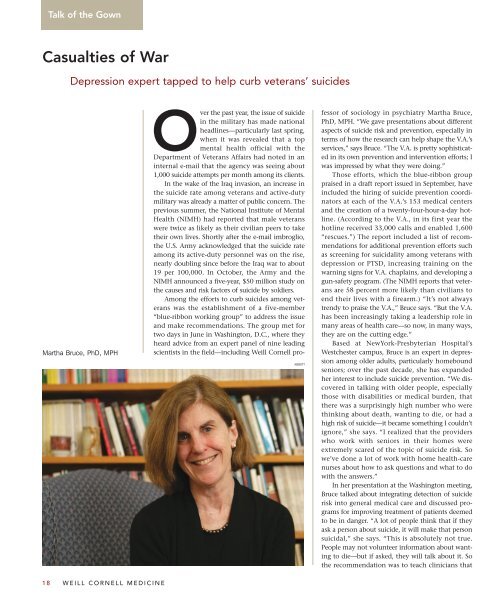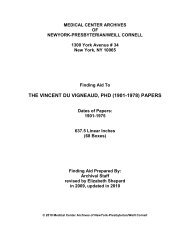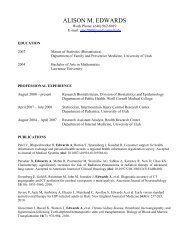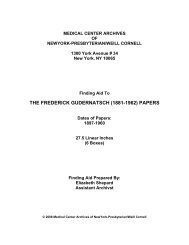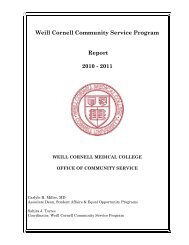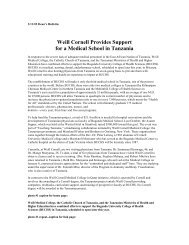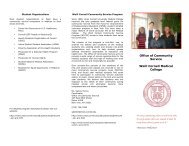Weillcornellmedicine - Weill Medical College - Cornell University
Weillcornellmedicine - Weill Medical College - Cornell University
Weillcornellmedicine - Weill Medical College - Cornell University
You also want an ePaper? Increase the reach of your titles
YUMPU automatically turns print PDFs into web optimized ePapers that Google loves.
Talk of the Gown<br />
Casualties of War<br />
Depression expert tapped to help curb veterans’ suicides<br />
Martha Bruce, PhD, MPH<br />
18 WEILL CORNELL MEDICINE<br />
Over the past year, the issue of suicide<br />
in the military has made national<br />
headlines—particularly last spring,<br />
when it was revealed that a top<br />
mental health official with the<br />
Department of Veterans Affairs had noted in an<br />
internal e-mail that the agency was seeing about<br />
1,000 suicide attempts per month among its clients.<br />
In the wake of the Iraq invasion, an increase in<br />
the suicide rate among veterans and active-duty<br />
military was already a matter of public concern. The<br />
previous summer, the National Institute of Mental<br />
Health (NIMH) had reported that male veterans<br />
were twice as likely as their civilian peers to take<br />
their own lives. Shortly after the e-mail imbroglio,<br />
the U.S. Army acknowledged that the suicide rate<br />
among its active-duty personnel was on the rise,<br />
nearly doubling since before the Iraq war to about<br />
19 per 100,000. In October, the Army and the<br />
NIMH announced a five-year, $50 million study on<br />
the causes and risk factors of suicide by soldiers.<br />
Among the efforts to curb suicides among veterans<br />
was the establishment of a five-member<br />
“blue-ribbon working group” to address the issue<br />
and make recommendations. The group met for<br />
two days in June in Washington, D.C., where they<br />
heard advice from an expert panel of nine leading<br />
scientists in the field—including <strong>Weill</strong> <strong>Cornell</strong> pro-<br />
ABBOTT<br />
fessor of sociology in psychiatry Martha Bruce,<br />
PhD, MPH. “We gave presentations about different<br />
aspects of suicide risk and prevention, especially in<br />
terms of how the research can help shape the V.A.’s<br />
services,” says Bruce. “The V.A. is pretty sophisticated<br />
in its own prevention and intervention efforts; I<br />
was impressed by what they were doing.”<br />
Those efforts, which the blue-ribbon group<br />
praised in a draft report issued in September, have<br />
included the hiring of suicide prevention coordinators<br />
at each of the V.A.’s 153 medical centers<br />
and the creation of a twenty-four-hour-a-day hotline.<br />
(According to the V.A., in its first year the<br />
hotline received 33,000 calls and enabled 1,600<br />
“rescues.”) The report included a list of recommendations<br />
for additional prevention efforts such<br />
as screening for suicidality among veterans with<br />
depression or PTSD, increasing training on the<br />
warning signs for V.A. chaplains, and developing a<br />
gun-safety program. (The NIMH reports that veterans<br />
are 58 percent more likely than civilians to<br />
end their lives with a firearm.) “It’s not always<br />
trendy to praise the V.A.,” Bruce says. “But the V.A.<br />
has been increasingly taking a leadership role in<br />
many areas of health care—so now, in many ways,<br />
they are on the cutting edge.”<br />
Based at NewYork-Presbyterian Hospital’s<br />
Westchester campus, Bruce is an expert in depression<br />
among older adults, particularly homebound<br />
seniors; over the past decade, she has expanded<br />
her interest to include suicide prevention. “We discovered<br />
in talking with older people, especially<br />
those with disabilities or medical burden, that<br />
there was a surprisingly high number who were<br />
thinking about death, wanting to die, or had a<br />
high risk of suicide—it became something I couldn’t<br />
ignore,” she says. “I realized that the providers<br />
who work with seniors in their homes were<br />
extremely scared of the topic of suicide risk. So<br />
we’ve done a lot of work with home health-care<br />
nurses about how to ask questions and what to do<br />
with the answers.”<br />
In her presentation at the Washington meeting,<br />
Bruce talked about integrating detection of suicide<br />
risk into general medical care and discussed programs<br />
for improving treatment of patients deemed<br />
to be in danger. “A lot of people think that if they<br />
ask a person about suicide, it will make that person<br />
suicidal,” she says. “This is absolutely not true.<br />
People may not volunteer information about wanting<br />
to die—but if asked, they will talk about it. So<br />
the recommendation was to teach clinicians that


